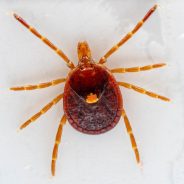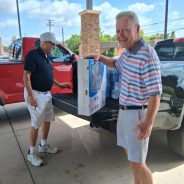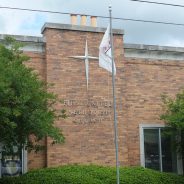Tick Talk: How to Spot, Avoid and Remove Ticks in Texas
June 20, 2025 – Texas A&M AgriLife expert shares tips to stay safe this tick season
As temperatures rise and Texans spend more time outdoors, the risk of tick bites increases across the state. It’s important to know how to spot, avoid and remove ticks in Texas, whether you’re hiking, camping, ranching or gardening.
Pete Teel, Ph.D., Texas A&M AgriLife Research entomologist and Regents Professor in the Texas A&M College of Agriculture and Life Sciences Department of Entomology, shares how to stay safe from ticks this season and why proper removal matters.
Most common tick species in Texas
“There are two common ticks in Texas: the Lone Star tick and the Gulf Coast tick,” Teel said.
Lone Star ticks are most active in late spring and throughout the summer. However, the Gulf Coast species is active year-round, especially in South Texas. Thus, these tick species are most active when outdoor activities are at their highest.
“Perhaps the most iconic human biting tick for Texas is the Lone Star tick, which gets its name from a single iridescent spot on the back of the adult female,” Teel said.
This tick has a wide host range, including many wildlife species and humans.
“You’ll most often encounter ticks when you enter their natural habitats,” Teel said. “This includes hiking, camping, trail riding or even ranching.”
To see more Texas tick species, visit Texas A&M AgriLife’s tick app.
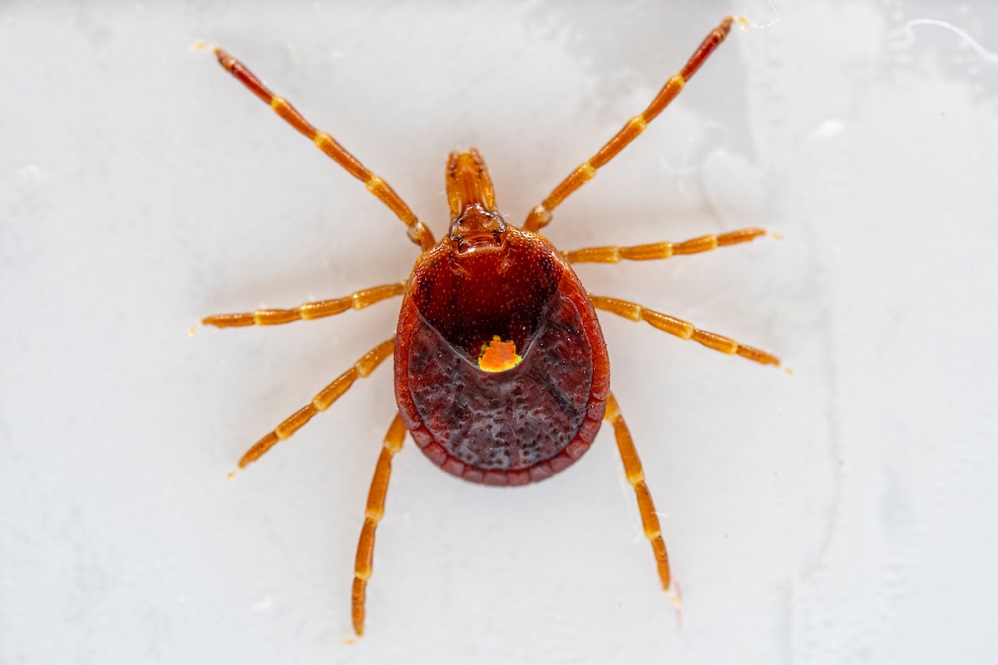
The Lone Star tick is possibly the most iconic human biting tick and is recognizable for its iridescent spot on the back of a female adult tick. (Michael Miller/Texas A&M AgriLife)
Tick prevention and detection
Ticks are surprisingly good at finding their next host. “They can detect heat, carbon dioxide, shadows and vibrations,” Teel said.
The first stage after being hatched from eggs is the larval stage. The six-legged larvae, which can swarm in big groups, may leave tiny red spots that are so small they go unnoticed.
Nymphs and adults are eight-legged and slightly larger than larvae, making these stages easier to see. However, they can still transmit disease-causing pathogens if they are not removed.
Teel recommends the following prevention steps to spot, avoid and remove ticks:
- Wear light colored clothing to help spot ticks.
- Tuck pants into boots or socks when walking through tall grass or brush.
- Consider using masking tape barriers made by folding tape lengthwise and wrapping around your tucked pant legs with the sticky side facing out to trap ticks as they crawl.
- Apply EPA-approved tick repellent.
- Conduct inspections for attached ticks.
- Properly remove attached ticks and hold them for observation.
“Always perform a tick check after outside activities. This can be for humans and your furry loved ones,” Teel said.
He explained a proper tick check inspection includes behind the ears, on the scalp, the waistline and under the arms.
How to safely remove a tick
“When removing a tick, it is important to not twist, jerk, burn or douse with chemicals because this may cause the tick to spit pathogens into the bite, causing a tick-borne illness,” Teel said.
Instead, he recommended following these steps:
- Use fine-tipped tweezers or a tick-removal tool to grasp the tick as close to the skin as possible.
- Pull straight out with steady, even pressure.
- Clean the area with an alcohol swab or antiseptic after removing the whole tick.
Teel said once the tick is removed, consider placing it in a closed bottle or bag and saving it. Ticks removed from Texas citizens can be submitted for identification and for tick-borne pathogen testing for free of charge to the Texas Department of State Health Services.
“Awareness and prompt action go a long way in preventing a tick-borne illness,” Teel said. “Know how to avoid ticks and how to properly remove them.”
More tick talk
To learn more and see maps of where tick species live in Texas and across the U.S., visit the Centers for Disease Control and Prevention’s page about where ticks live.
SEE WHERE TICKS LIVE
-30-

Social Security Administration Raises Full Retirement Age
June 20, 2025 – Beginning May 2025, pre-retirees will need to wait longer to receive their full Social Security benefits. The full retirement age (FRA) has increased gradually since 1983, after former President Ronald Reagan signed the Social Security Amendments.
For those born in 1960 or later, the full retirement age is 67. The FRA change was phased in over 22 years, and the full retirement age of 67 is effective for those born in 1960 or later.
- Born 1958: 66 and 8 months
- Born in 1959: 66 and 10 months
- Born in 1960 or later: 67
It’s possible to claim Social Security retirement benefits as early as age 62; however, the longer you wait to claim Social Security, the bigger your monthly check will be — until age 70, when you reach your maximum benefit.

Secretary Rollins Announces Bold Plan to Combat New World Screwworm’s Northward Spread From Mexico
(Edinburg, TX, June 18, 2025) – U.S. Secretary of Agriculture Brooke L. Rollins this morning launched an $8.5 million sterile New World screwworm (NWS) fly dispersal facility in South Texas and announced a sweeping five-pronged plan (PDF, 434 KB) to enhance USDA’s already robust ability to detect, control, and eliminate this pest. These urgent actions are necessary to finish the fight against NWS and protect the United States.
NWS is a devastating pest that causes serious and often deadly damage to livestock, wildlife, pets, and in rare cases, humans. While NWS has been eradicated from the United States for decades, recent detections in Mexico as far north as Oaxaca and Veracruz, about 700 miles away from the U.S. border, led to the immediate suspension of live cattle, horse, and bison imports through U.S. ports of entry along the southern border on May 11, 2025.
“The United States has defeated NWS before and we will do it again,” said Secretary Rollins. “We do not take lightly the threat NWS poses to our livestock industry, our economy, and our food supply chain. The United States government will use all resources at its disposal to push back NWS, and today’s announcement of a domestic strategy to bolster our border defenses is just the beginning. We have the proven tools, strong domestic and international partnerships, and the grit needed to win this battle.”
Following the dispersal facility groundbreaking at Moore Air Base, Secretary Rollins will meet with APHIS’s cattle fever tick riders along the Rio Grande River. The Secretary will see firsthand the critical role tick riders provide for identifying wildlife and preventing the spread of wild disease. In the event NWS advances northward into the U.S., these tick riders will play a crucial role in spotting and combatting this pest.
Key Facets of USDA’s Five-Pronged Plan (PDF, 434 KB) to Address New World Screwworm
1. Stop the Pest from Spreading in Mexico and Ensure We Are Full Partners in Eradication
- USDA’s recent $21 million expenditure went toward renovating an existing fruit fly production facility in Metapa, Mexico, which will provide an additional 60-100 million sterile flies a week to stop the spread, on top of the over 100 million already produced in Panama. This will result in at least 160 million flies per week.
- Over the last two weeks, USDA conducted a robust, in-person audit of Mexico’s animal health controls and will maintain close continual monitoring of these aspects moving forward and will make continuous improvements. These in-person visits have allowed a unique opportunity for APHIS to see first-hand the challenges and opportunities in Mexico toward combating NWS.
- USDA is working closely with Mexico to improve its surveillance and detection of NWS, which includes but is not limited to regularly providing traps, lures, and technical expertise to Mexico.
2. Protect the U.S. Border at All Costs
- USDA will support Mexico’s strategic trapping along our shared border and ensure we receive regular reporting as an early warning intervention.
- USDA will escalate communications and public outreach along the U.S.-Mexico border to create a “barrier zone of vigilance” and boost as close to real time as possible awareness of this pest.
- APHIS cattle fever tick riders in collaboration with U.S. Customs & Border Protection and with state partners will intercept and treat stray and illegally introduced livestock.
3. Maximize Our Readiness
- USDA will partner with state animal health officials to update and finalize emergency management plans and support federal, state, and local responders in training on and practicing for a potential response.
- USDA will ensure we have sufficient NWS treatments and will work to remove any federal regulatory hurdles for their use.
4. Take the Fight to the Screwworm
- Because sterile NWS flies are one of the most important and proven tools we have for eradicating the pest, USDA will immediately begin building a sterile insect dispersal facility at Moore Air Base, set to be completed in 2025. This facility will have the capability to disperse sterile flies in Northern Mexico.
- USDA is exploring all options to eradicate NWS, which includes potential expenditures in new technologies, new science, including possible plans to move forward with the design process of a domestic sterile fly production facility to compliment the new dispersal facility at Moore Air Base which has also been identified as the proposed location. The facility could boost domestic sterile fly production by up to 300 million flies per week and could complement current production that already exists in Panama and Mexico.
5. Innovate Our Way to Eradication
- USDA is pursuing innovative research to improve sterile insect technology, exploring development of better traps and lures, exploring next generation NWS treatments, and assessing the potential use and practicality of additional strains or genetically modified versions of the pest as well as e-beam and other radiation technology for the production of sterile flies.
- USDA will strengthen partnerships with land-grant universities in border states such as Texas, Arizona and New Mexico to facilitate local training, trap deployment, surveillance validation, and stakeholder outreach as an initial manner.
Additionally, to solicit input from stakeholders and to best inform the finalization of future plans, USDA will hold four public listening sessions to get feedback on the following topics: sterile fly production technology, eradication tools and technologies aside from sterile fly production, the benefits and barriers including timelines and costs of enhanced domestic vs international sterile fly production, and other innovative ideas. The Department of Agriculture has and remains committed to working in close coordination with our federal, state, local and private sector partners to defeat this pest once and for all.
“Texas is on the front lines of the threat posed by the New World Screwworm. Proactive measures like this dispersal facility are a critical step to ensure our state and nation are prepared to respond swiftly and effectively to this challenge. We are grateful for the Trump Administration and Secretary Rollins’ continued support of Texas in safeguarding the economic vitality of our farming and ranching communities. We will continue to work with our federal partners to eliminate this threat,” said Governor Greg Abbott.
“If we do not take action now, the New World Screwworm will devastate Texas livestock and wildlife. Thank you, Secretary Rollins, for swiftly accepting my proposal to establish this critical facility in Hidalgo County. I am committed to working alongside the Administration to put Texas farmers and ranchers first and safeguard our agriculture industry,” said Representative Monica De La Cruz.
“Today’s policy changes represent a huge step forward to eradicating the screwworm and protecting American livestock— especially the opening of a U.S.-based eradication facility in South Texas. This facility has been one of my top priorities in Congress. From introducing the STOP Screwworms Act to leading funding efforts through my seat on the House Appropriations Committee, I am determined to do everything possible to eliminate this deadly parasite. Thank you, Secretary Rollins, for your partnership and commitment to deliver for our farmers and ranchers in Texas and across the nation,” said Representative Tony Gonzales.
“The return of the New World Screwworm is a glaring potential threat to South Texas ranchers, wildlife, and communities as a whole. If it reaches our country, this pest could wreak havoc on our economy and food supply chain. It must be eradicated. I look forward to working with USDA and other partners on innovative solutions right here at Moore Air Base to ensure the safety of our agricultural industry and South Texans’ wellbeing,” said Representative Vicente Gonzalez.
“The New World screwworm poses a serious threat to our cattle, economy, and food supply, but with Secretary Rollins’ leadership and USDA’s new 5-Prong Strategy, we’re taking aggressive action to stop it and protect America’s farmers and ranchers. As the Representative for the largest cattle-feeding district, I am committed to working closely with the Secretary to ensure we have every necessary tool to safeguard our livestock producers and feeders and their way of life,” said Representative Ronny Jackson.

“I’m proud to partner with decisive leaders such as USDA Secretary Rollins and our Texas congressional delegation in combating the New World Screwworm. This is a significant threat, and it’s critical we stay ahead of it. Texas has historically been at the forefront of American agriculture, and we are prepared to assist Secretary Rollins and the USDA in protecting our livestock, economy, and food supply. I look forward to implementing a robust, effective plan to protect Texas agriculture from this dangerous pest,” said Commissioner of Agriculture Sid Miller.
“Curbing the spread of the destructive New World screwworm is critical to protecting the Texas agriculture and livestock industry, and this new sterile fly distribution facility in Edinburg is a significant step in the right direction,” said Senator John Cornyn. “I will continue to work alongside Secretary Rollins and my colleagues in Congress to halt the spread of New World screwworm and increase our sterile fly production capacity through my STOP Screwworms Act.”
“The only way to protect the American cattle herd from the devastating threat of New World screwworm is by having a sufficient supply of sterile flies to push this pest away from our border,” said National Cattlemen’s Beef Association President Buck Wehrbein, a Nebraska cattleman. “To accomplish that, we need a sterile fly production facility of our own in the United States. Moore Air Base was previously part of our nation’s screwworm eradication effort in the 1960s and now this base will be the cornerstone of our renewed fight against this parasite. NCBA, and state affiliate partners including the Texas and Southwestern Cattle Raisers Association and Texas Cattle Feeders Association, have been pushing for a facility like this since the start of the year. We appreciate Secretary Rollins’ continued work to protect American agriculture from the New World screwworm. It’s an honor to join her in Texas for this important event.”
“Texas Farm Bureau applauds U.S. Secretary of Agriculture Brooke Rollins for advancing the construction of a sterile insect production and distribution facility at Moore Air Base. This investment is a critical step in protecting Texas livestock, wildlife and our food supply from the devastating threat of the New World screwworm (NWS). As the screwworm threat has moved north from Panama into Mexico, Texas Farm Bureau made the establishment of a domestic sterile insect facility one of our highest priorities. A robust, science-based defense, anchored by a U.S.-based facility, is essential to combatting this destructive pest. We’re grateful to the Congressional leaders who have championed this effort and to USDA for its commitment to proactive, long-term solutions. We look forward to continued collaboration to ensure our producers, rural communities and consumers are protected from this threat,” said Texas Farm Bureau President Russell Boening.
“We commend Secretary Rollins for prioritizing efforts to combat New World Screwworm by establishing sterile fly dispersal and production facilities in South Texas which will significantly enhance our capabilities to contain the screwworm in Southern Mexico,” said Texas Cattle Feeders Association chairman-elect Laphe LaRoe. “These additional resources, combined with robust implementation of surveillance, sampling, reporting and enhanced treatment protocols provide a strong foundation for the U.S. to continue fighting the screwworm fly where it is today and ensure continued confidence in cattle and beef trade between the U.S. and Mexico.”
“Today’s announcement is pivotal in protecting the U.S. cattle industry. Sterile flies are the only known way to stop the reproduction and continued expansion of New World screwworm, and it’s assuring to see Secretary Rollins follow through her early commitments to increasing production of sterile flies domestically,” said Texas & Southwestern Cattle Raisers Association First Vice President Stephen Diebel.
Guardrails Aren’t Free
June 20, 2025 – By Tila Grant – DALLAS — Guardrails are built to save lives, but repairing them comes at a steep cost, one that ultimately impacts every Texas taxpayer.

Every week, TxDOT crews respond to damaged guardrails across the state, deploying emergency repair teams to repair them alongside our highways. These repairs are essential — but they can come with a hefty price tag, as well. Motorists should also know that, should damage occur, TxDOT will seek reimbursement to help defray those costs.
The cost to taxpayers
In Dallas County alone, more than $4.9 million has been spent on guardrail-related repairs. The majority, over $4.6 million, went toward replacing Guardrail End Treatment Systems, which are designed to absorb crash impact and reduce the severity of collisions. These systems have been used more than 200 times in Dallas County this year — each replacement funded by public dollars.
In Denton County, monthly repair costs range from $90,000 to $100,000, with over $600,000 in damage claims submitted this fiscal year. One crash involving an 18-wheeler that crashed on FM 428 caused extensive damage and a hefty repair bill.
Across Texas, labor costs alone have surpassed $800,000 so far this year a figure that doesn’t include materials, equipment, or contractor overhead.
What these repairs cost
- Narrow attenuator repair: $4,200
- Wide attenuator repair: $57,512
- Replacing 28 Gibraltar posts after a single crash cost: $11,200
These aren’t just numbers, they’re taxpayer dollars at work.
What drivers can do
While TxDOT does pursue reimbursement from insurance companies when possible, not all costs are recoverable. That means every crash into a guardrail is a potential hit to the public budget.
To help protect lives, and your wallet, we urge all Texans to:
- Slow down, especially in wet or icy conditions
- Avoid distractions behind the wheel
- Stay alert in construction zones and high-speed areas
Every damaged guardrail is a reminder of a crash that could have ended far worse, but also a reminder that preventable accidents come with a public price tag.
Let’s work together to keep our roads safe — and our tax dollars focused more on building and maintaining, and less on repairing.
Designer Handbag Bingo Table Sales Begin Monday at Midnight
June 19, 2025 – Sulphur Springs, Texas – Tables for the Hopkins County Health Care Foundation’s Designer Handbag Bingo go on sale this Monday, June 23rd. Seats at this event are highly coveted, so we recommend having a game plan with your tablemates to ensure you get to play.
Luxury handbags from designers such as Louis Vuitton, Staud, Chloe, Tori Burch, Stella McCartney, Consuela, Brighton, Strathberry, and Kate Spade will make all the planning worth it. Consider spending a fun evening with friends and funding a free mammography clinic the cherry on top!
Tables are $615 and include seating for 8 people, with each guest receiving a packet containing 10 rounds of regular bingo, a drink ticket, and a door prize entry. Bookmark the website, handbagbingo25.GiveSmart.com, and be ready to save your spot. August 7th will be a night to remember!
Our title sponsor, Alliance Bank, Alliance Bank Financial Services, and Galyean Insurance always brings the fun and an unforgettable bag.
The Foundation is an IRS designated 501 (c)(3) nonprofit organization founded in 1997. The Foundation is expanding healthcare opportunities in Hopkins County by offering clinics and programs to the public, as well as funding equipment for the local hospital and Hospital District.
###
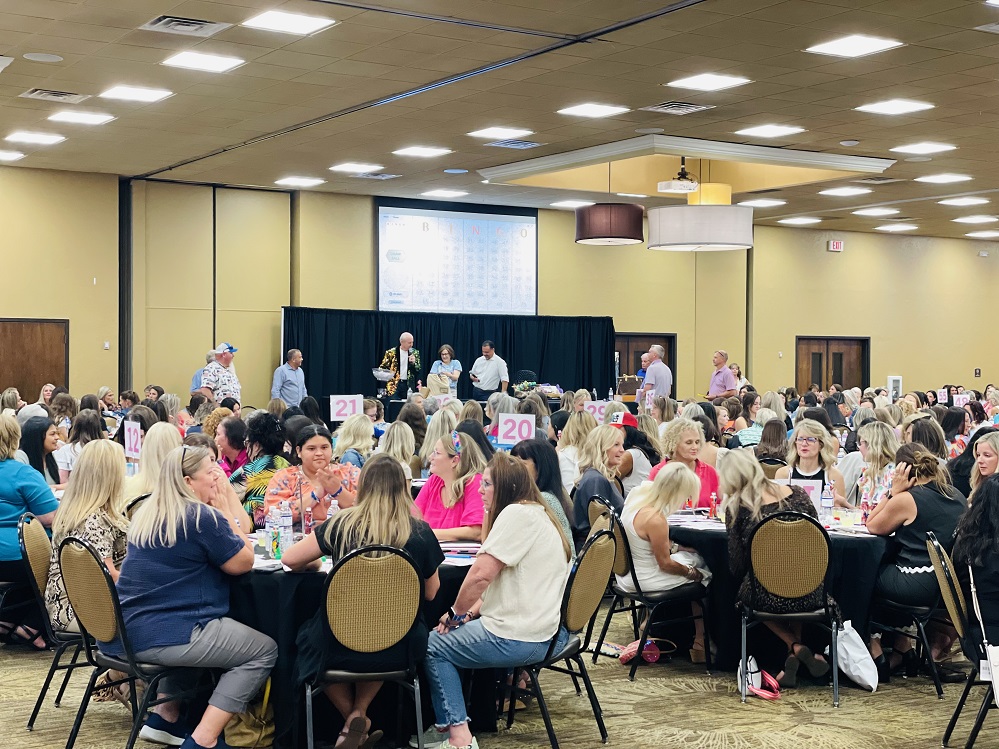
Local Corvette Club Donates Fans to Senior Citizen Center
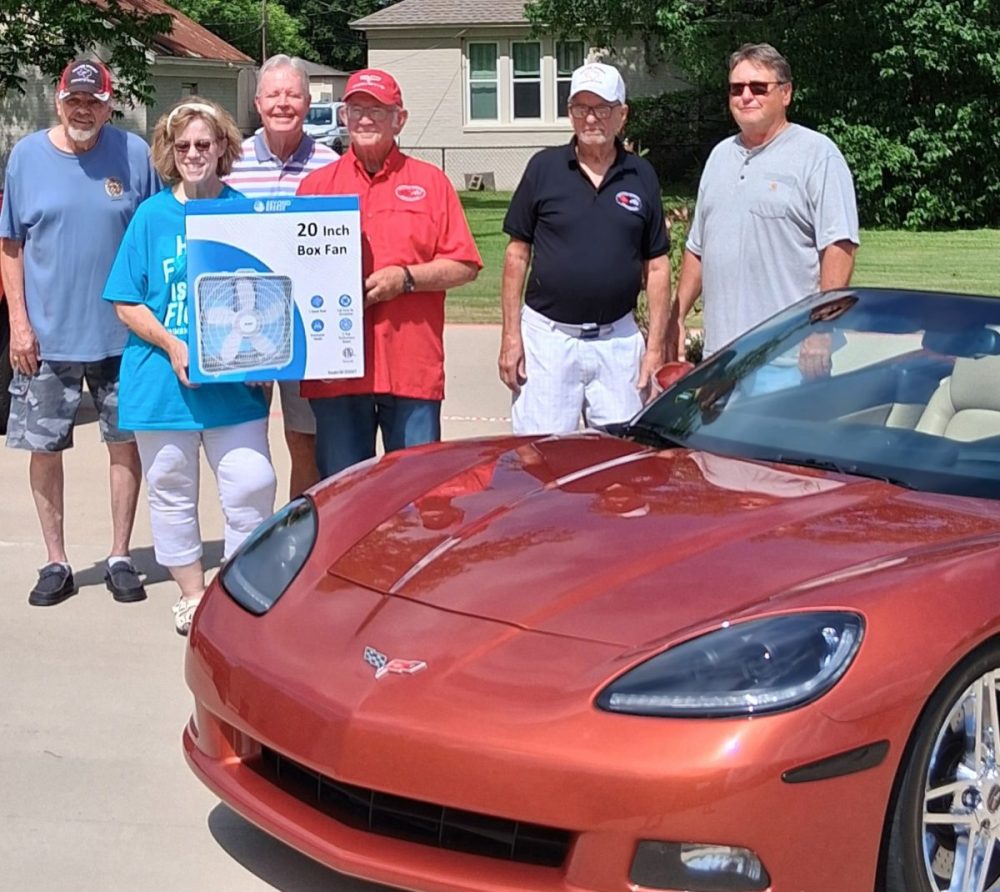
June 19, 2025 – As summer approaches, the heat inside the homes of local seniors will be on the rise. Being able to move a little air becomes a huge benefit to help keep seniors cool and keep their electricity costs down. Several members of the Sulphur Springs Corvette Club zoomed on over delivering fans to Dawna Pryor, director of the Sulphur Springs Senior Center.
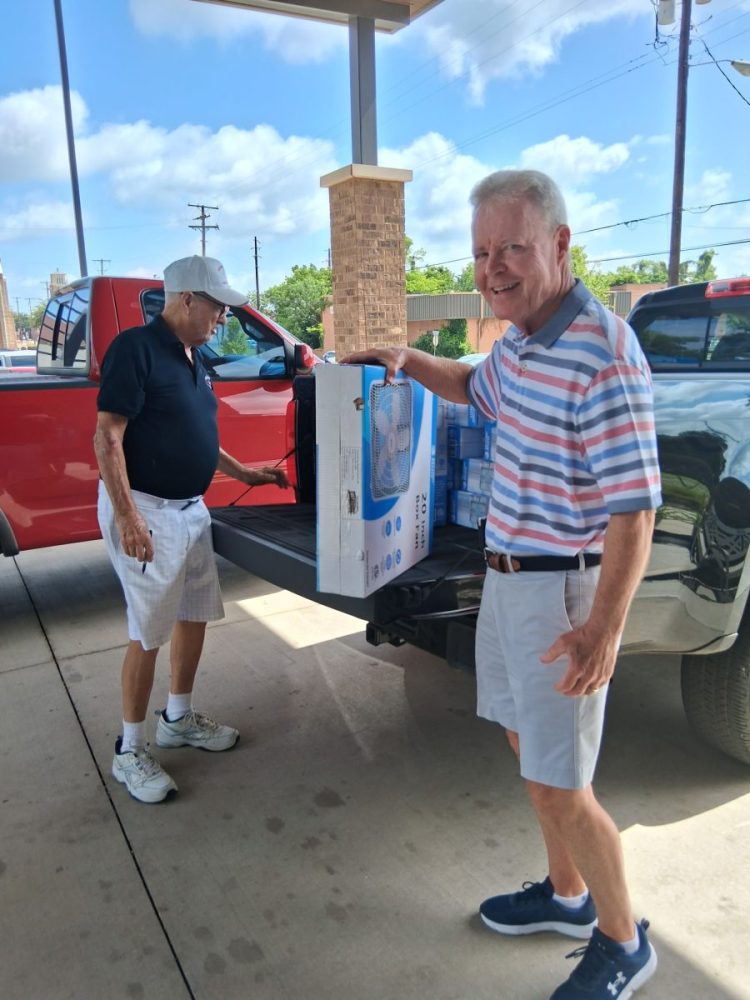
Dinner Bell for June 25, 2025
DINNER BELL, First United Methodist Church
SPONSOR: Money Law and Title
First United Methodist Messengers Sunday School Class
The doors to Fellowship Hall at First United Methodist Church will open at 11:00 a.m. Meal service begins at 11:30 a.m. and doors will close at 12:45 p.m. Please come join us to share fellowship and a meal.
Money Law and Title relocated its Sulphur Springs office to the spacious red brick building on the Southeast corner of the downtown square and Oak Avenue.
Real estate transactions and closings require legal expertise and Money Law opened in 2013 with the title fee office open ing in 2016; and, in 2022 the law and title companies became one agency known as Money Law and Title.
They also have offices located in Greenville, Sulphur Springs, Terrell, Emory, Prosper and Sherman, Texas to serve the needs of the people of the North and Eastern areas of the state.
We also welcome our second partner for June 25th Dinner Bell Ministry, First United Methodist Church, Messengers Sunday School Class. In mid-summer, 1955, a small band of young couples and a few singles bonded together to form a new Sunday school class. They chose the name “Messengers”. The class exists today, but has dwindled in membership from a high of over 100 to the mid-20’s.
Jackie Brice and Martha Kate Brem Chapman are the only original members alive today, but they are inactive. Christine Payne was a very loved teacher, but Kearney Brim, Laurine Garrison, Phil Morgan and Tom Young filled rolls as teachers of the Bible-based curriculum throughout the years. As the years passed, this class provided many leaders for the First United Methodist Church.
We plan to continue inside dining every Wednesday with the exception of the Wednesday before Thanksgiving, Christmas and New Years Day.
MENU:
- Chicken Thighs in a Creamy Garlic Parmesan Sauce
- Rice Cooked in Chicken Stock
- Arkansas Green Beans
- Garden Salad
- Banana Pudding
The Dinner Bell Ministry
First United Methodist Church
Take care of YOURSELF!
Wash your hands often! Get inoculated and boosted
DINNER BELL CARES ABOUT YOUR HEALTH !!!
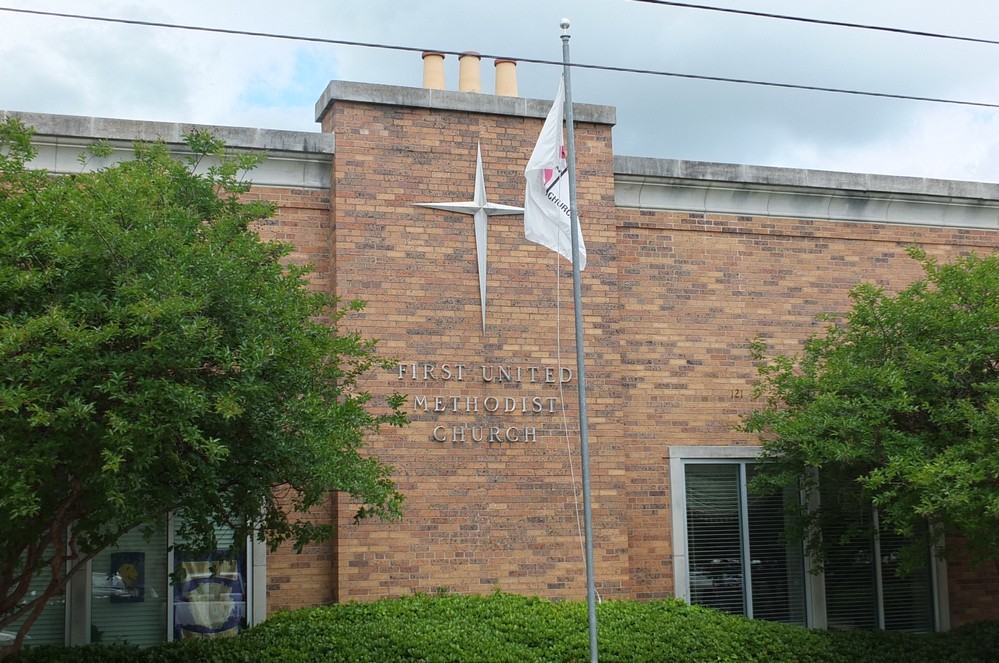
Texas Hemp and THC Bill In Limbo
June 18, 2025 – With just days remaining until the signing deadline, Texas Governor Greg Abbott has not publicly indicated whether he will approve or veto Senate Bill 3, a highly controversial measure that would ban products containing THC, including hemp-derived items like Delta-8 and Delta-9. The uncertainty has left the state’s booming legal hemp industry in limbo, as businesses, consumers, and industry advocates anxiously await Abbott’s decision.

The bill has been aggressively championed by Lt. Gov. Dan Patrick, who has pushed for stricter regulation of THC products, arguing they pose safety risks and bypass the state’s restrictions on marijuana. Patrick’s office has applied significant political pressure on Abbott to sign the bill, framing it as a matter of public health and law enforcement.
On the other side, the legal hemp industry—which has grown into a multibillion-dollar sector in Texas—is fighting to preserve access to THC products that have become widely available in stores since the federal legalization of hemp in 2018. Industry leaders warn that the ban would shutter thousands of small businesses, eliminate jobs, and push consumers toward illicit markets. Supporters of the industry also argue that hemp-derived THC products provide therapeutic benefits and that Texans should retain the freedom to purchase them legally.
Governor Abbott’s silence on the issue has only intensified speculation. He has historically walked a careful line on cannabis-related legislation, supporting limited medical use while opposing broader legalization. Whether he sides with Patrick’s hardline stance or responds to industry and consumer pushback remains to be seen.
If Abbott neither signs nor vetoes the bill by the deadline, it will automatically become law, potentially triggering swift legal challenges. For now, Texas businesses and consumers are left in a state of uncertainty, awaiting the governor’s next move.
Cooper Lake Supervisor Aron Maib On Second Cup Of Coffee
June 18, 2025 – Cooper Lake State Park Supervisor Aron Maib stopped by for a Second Cup Of Coffee With John Mark Dempsey to chat about what’s going on at Cooper Lake. John Mark and Aron discussed the new improvement construction projects planned for the park such as a new fishing pier, new roofs, and much more. They also talked about the Skin and Skulls event and Art in the Park both taking place at Cooper Lake on June 21st. They also discussed the Stargazing Event planned for June 28th, 2025. The two discussed the water level at the lake as well, and so much more. Be sure to check out this episode below and learn what’s happening at Cooper Lake State Park!

Brian Crump ED of CANHelp On Second Cup of Coffee With John Mark Discuss Give Back Day and Back to School Fair
June 18, 2025 – Brian Crump, the Executive Director of CANHelp, sat down and had a Second Cup Of Coffee chat with KSST’s John Mark Dempsey. The two talked about CANHelp’s fundraiser Giveback Day with Dutch Bros in Sulphur Springs, Texas, taking place June 20th, 2025. The two also discussed CANHelp’s Back to School Fair coming up August 7th, 2025, at the ROC downtown Sulphur Springs. They talked about how registration for the backpacks is underway right now. Watch this episode of KSST”s A Second Cup Of Coffee With John Mark Dempsey below and learn how you can participate in the Giveback Day and what you need to do to register for the Back to School Fair. “Together we CAN Help!”



